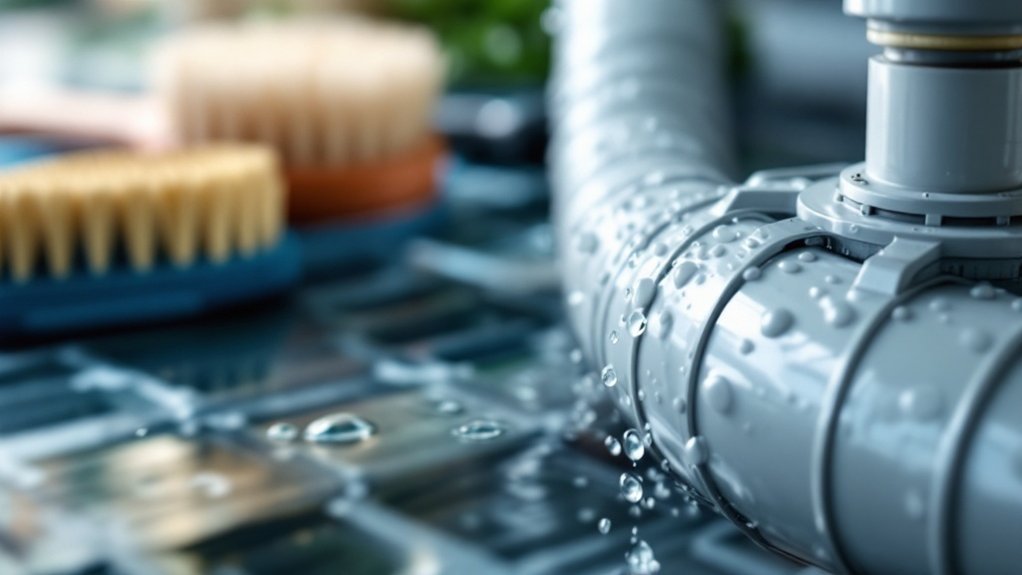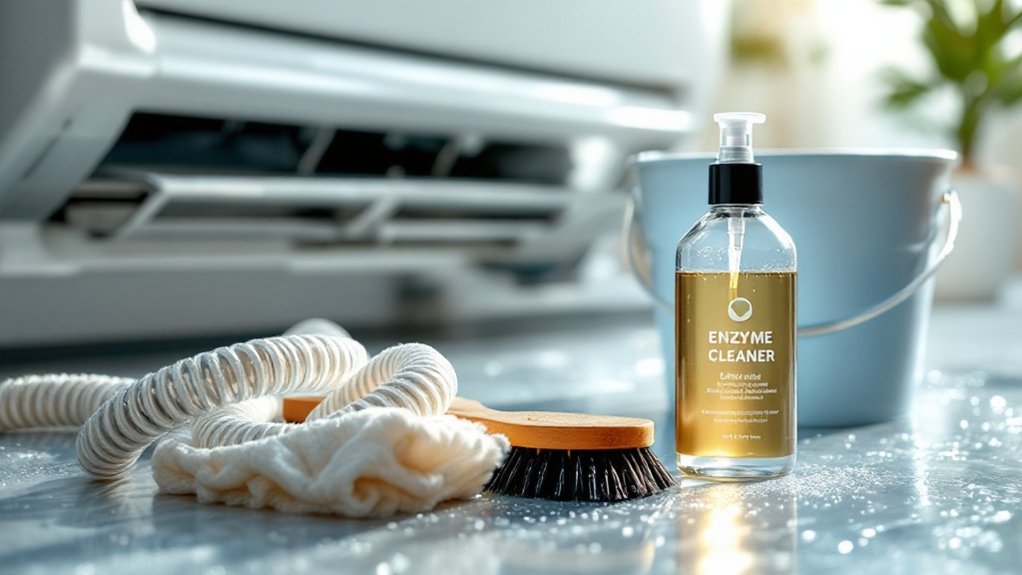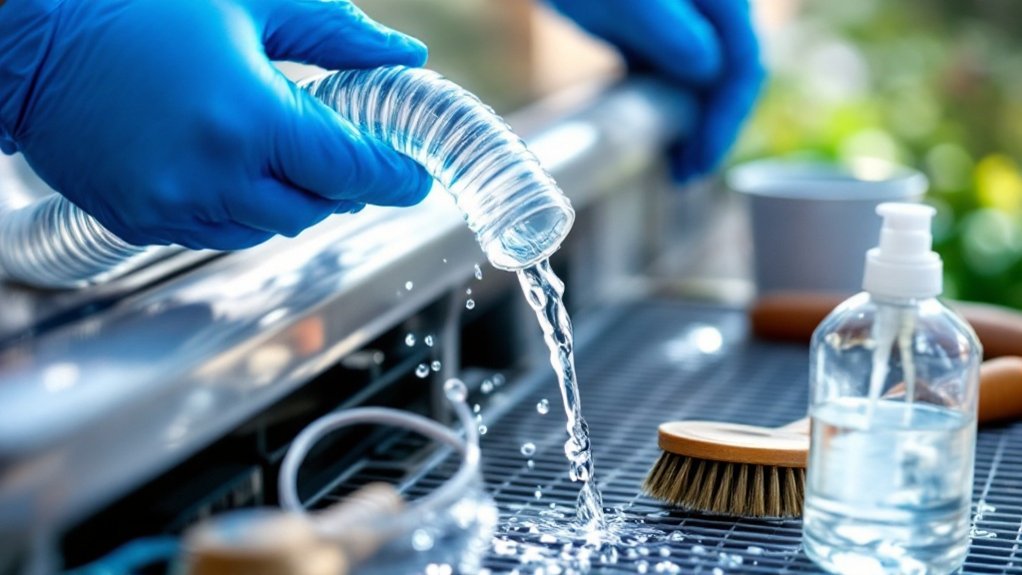To clean your aircon drainage pipe, first shut off power at the circuit breaker. Place a container beneath access points, then flush the pipe with vinegar, bleach, or hydrogen peroxide solution. For stubborn clogs, use a wet-dry vacuum, plumber’s snake, or pressure washing at 30-60 PSI. Maintain your system monthly with vinegar flushes and regular filter changes. Wearing gloves and safety goggles protects you throughout this essential maintenance task. The following guide covers even more effective techniques.
Key Takeaways
- Turn off power to the AC unit at the circuit breaker before beginning any cleaning work for safety.
- Use a wet-dry vacuum at the drain line’s end to suction out clogs or a plumber’s snake to push through blockages.
- Flush the drainage pipe with a solution of vinegar, hot water, or hydrogen peroxide to kill algae and dissolve buildup.
- Clear the drain pan of debris and check for proper slope to ensure water flows correctly through the system.
- Perform monthly maintenance by pouring 1 cup of vinegar down the drain line to prevent future clogs and algae growth.
Understanding Your Air Conditioner’s Drainage System

While many homeowners focus on their AC unit’s cooling capacity, the drainage system plays an equally critical role in its overall functionality.
Your air conditioner’s drainage system consists of an evaporator coil that condenses humidity, a drip pan that collects water, and a drain line that channels it away.
Effective moisture management prevents mold growth, water damage, and extends your unit’s lifespan. Additionally, understanding the importance of stormwater management can help prevent drainage issues that may arise from external factors.
Drainpipe materials typically include PVC or metal, each with specific maintenance requirements.
The system may operate via gravity or pump mechanisms to remove excess water.
Understanding these components helps you maintain proper drainage and avoid costly repairs from water accumulation or corrosion.
Essential Tools and Materials for AC Drain Cleaning

Now that you’re familiar with your air conditioner’s drainage system, you’ll need the proper tools and materials to perform effective maintenance.
For basic drain cleaning, gather protective gear including gloves and safety glasses. Essential supplies include flushing solutions like vinegar, bleach, or hydrogen peroxide, along with hot water to dissolve buildups.
For thorough maintenance, invest in specialized equipment such as a wet-dry vacuum with a CLT-1 attachment, flexible tube brushes, or a plumber’s snake for stubborn clogs.
Don’t forget containers for mixing solutions and collecting debris. These tools guarantee your drain maintenance tips translate into effective, long-lasting results.
Step-by-Step Cleaning Process for Beginners

Before starting the cleaning process, you’ll need to gather vinegar, a funnel, protective gloves, and a wet/dry vacuum for effective drainage pipe maintenance.
Guarantee your safety by turning off the air conditioner completely and disconnecting power to prevent accidental startups while working on the system.
Position a small container beneath any access points to catch potential water or debris that may discharge during the cleaning procedure.
Essential Cleaning Supplies
Gathering the right cleaning supplies is critical before attempting to clean your aircon drainage pipe.
You’ll need bio-enzymatic cleaning fluids or specialized AC condensate cleaners like Instant Power for effective maintenance. For basic cleaning techniques, white vinegar, dish soap, and clean water work efficiently to break down organic buildup.
An AC drain adapter tool is essential for proper flushing, allowing you to connect a water source directly to the drainage pipe.
For stubborn clogs, consider industrial-strength drain removers in gel form.
Our product recommendations include iFLO automated systems for regular maintenance and a wet/dry vacuum for extracting persistent blockages.
Safety First Steps
Guaranteeing your safety should be the top priority when cleaning an aircon drainage pipe, as improper procedures can lead to electrical hazards or system damage. Before starting, completely power off your AC unit at the circuit breaker—not just from the remote control.
| Safety Precaution | Why It’s Essential |
|---|---|
| Cut power at breaker | Prevents electrical hazards |
| Wear protective gloves | Guards against bacteria and chemicals |
| Use safety goggles | Protects eyes from splashing solutions |
| Read manufacturer manual | Guarantees system-specific requirements are met |
Always wear appropriate safety gear when handling cleaning solutions. Never rush this process—electrical hazards can occur if proper shutdown procedures aren’t followed.
Advanced Techniques for Stubborn Clogs
When conventional methods fail, you’ll need to employ pressure-washing your aircon system using a compressor set to 30-60 PSI while securing the nozzle tightly to the pipe opening.
Cover the pipe outlet with a rag to prevent splashing and avoid excessive pressure that might damage PVC components.
For persistent bio-growth issues, apply chemical treatments like vinegar or hydrogen peroxide, allowing them to sit for 30 minutes before flushing thoroughly with hot water to maximize their effectiveness.
Pressure-Washing the System
Tackle stubborn aircon drainage clogs with pressure-washing, a powerful technique that dislodges even the most resistant blockages that simpler methods can’t address.
First, turn off your AC’s power and locate the condensate drain. Attach a taped extended tip to your compressed air source set to approximately 30 PSI. This pressure washing benefit guarantees effective debris removal without damaging pipes.
Insert the tip firmly into the access point and apply short bursts of air.
Pressure washing tips: maintain moderate pressure to avoid separating joints, follow with clean water to flush loosened buildup, and use a shop vac to extract remaining debris.
Chemical Bio-Growth Treatments
Persistent aircon drainage clogs often require chemical intervention when mechanical methods prove insufficient.
For effective bio growth prevention, pour ¼ cup of vinegar or hydrogen peroxide into the drain line, allowing it to sit for 30 minutes before flushing with hot water. Always turn off your AC unit and wear protective gear during this process.
For best results, treat your drainage pipe monthly, especially in high-humidity environments.
Chemical alternatives include dish soap solutions, though they’re less effective against organic buildup.
Remember to securely replace the drain cap after treatment to prevent future contamination and maintain system efficiency.
Preventative Maintenance to Avoid Future Blockages
Four key strategies can help you maintain a blockage-free aircon drainage system long-term.
First, implement preventative measures like properly sloping the drain line and covering drain exits to prevent debris entry.
Proper slope and covered drain exits are your first line of defense against debris-caused blockages.
Second, schedule routine inspections to identify potential issues before they become major problems.
Third, flush your drain line monthly with a vinegar solution to dissolve biofilm and prevent algae growth.
Finally, maintain your entire HVAC system by regularly replacing air filters and keeping the area around outdoor units clear of obstructions.
Document all maintenance activities to track performance and identify recurring issues over time.
Warning Signs of a Clogged Drainage Pipe
Recognizing the early warning signs of a clogged aircon drainage pipe can prevent costly water damage and system failures.
Watch for standing water around your unit or in the drain pan—this directly indicates drainage blockage. If you notice unexpected drips, leaks, or your system shuts off repeatedly, your drainage pipe likely needs attention.
Mold growth, musty odors from vents, and increased humidity are telltale indicators requiring immediate drainage maintenance.
Visual damage like rust or water stains suggests long-term issues. For effective clog prevention, don’t ignore performance issues like diminished cooling capacity—these often signal drainage problems requiring prompt action.
Safety Precautions Before and During Cleaning
Before attempting to clean your aircon drainage pipe, you must prioritize safety to prevent electrical hazards and personal injury. Always disconnect power to your air conditioning unit before beginning any maintenance work.
Your cleaning checklist should include proper safety gear:
- Wear protective gloves and safety goggles to shield against debris and cleaning agents.
- Use a stable ladder with non-slip feet when accessing elevated drainage pipes.
- Confirm adequate lighting in your work area to clearly see potential hazards.
Maintain a clear workspace free of obstacles that could cause trips or falls while you’re focused on the cleaning task.
When to Call a Professional HVAC Technician
While many aircon drainage pipe issues can be resolved with DIY cleaning methods, certain situations demand professional intervention from qualified HVAC technicians.
Watch for these signs requiring professional intervention: persistent water leaks despite cleaning, unusual odors indicating possible mold growth, or strange noises during operation.
Don’t ignore warning signs – persistent leaks, unusual odors, or strange noises demand immediate professional attention.
If your system experiences frequent cycling, inconsistent cooling performance, or sudden energy bill spikes, these may signal deeper problems beyond drainage issues.
Additionally, call professionals when you notice electrical components near water damage, if your warranty requires certified maintenance, or if drainage problems recur despite your best cleaning efforts.




